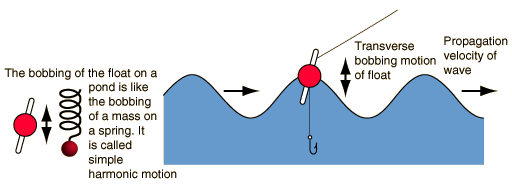Transverse and Longitudinal Waves
Andre Beroukhim
Short Description of Topic
Waves are the way in which energy is transferred. Of the many different types of waves, some can be divided into either transverse or longitudinal waves. Definitions:
For Longitudinal waves, the displacement of the medium is parallel to the direction of propagation of the wave (direction of the wave's travel)
For Transverse waves, the displacement of the medium is perpendicular to the direction of propagation of the wave (direction of the wave's travel)
The Main Idea
State, in your own words, the main idea for this topic
The idea behind this topic is to compare two types of waves and the ways in which they can be found in real life. Nearly any type of wave can be defined as a transverse or a longitudinal wave and the ability to categorize waves into these two categories is extremely useful for energy transfer concepts. To elaborate -- consider light, which is a transverse wave. Light waves can pass through particles that have tigthly packed particles, and these particles in the wave collide with those in the medium, which is why light passes through different mediums with different refraction patterns. Longitudinal waves, such as sound for example, travel directly parallel to the energy transfer. A nice real life example to think of is how we can hear things from outside a room if just the door is opened -- because sound can bend from outside to the door into the room. Light however, does not bend as easily which is why we won't see a lot of light when in a room with just the door open. This example is just one of the many where transverse and longitudinal waves demonstrate different properties.
Comparing the two wave types: [1]
A Mathematical Model
What are the mathematical equations that allow us to model this topic. For example [math]\displaystyle{ {\frac{d\vec{p}}{dt}}_{system} = \vec{F}_{net} }[/math] where p is the momentum of the system and F is the net force from the surroundings.
TRANSVERSE WAVES
Ocean Waves
 [2]
[2]
Sin Curves are directly related to ocean waves because of their visual rate of flow as well as how they transfer energy! Think about surfing - it's much easier to surf if you understand how the water is moving and what patterns it produces.
LONGITUDINAL WAVES
How does momentum and impulse transfer through a slinky (Wave)? [3]
A Computational Model
How do we visualize or predict using this topic. Consider embedding some vpython code here Teach hands-on with GlowScript
Examples
Transverse [4]
Simple
Question 1: Compare a Transverse Wave to a Sin curve. What are 4 properties of trigonometric curves (think Asin(Bx+C)+D)? What is the top point called? Bottom point?
Q2: What sort of energy is mainly transferred in a wave on the sea: Heat, Kinetic, or Potential?
Q3: If you float in gentle waves - in what direction do you move ?
Middling
Question 1: [5]
Q2: In what direction do the water particles move in a wave: Toward you, away from you, or up and down?
Q3: [6]
Q4: If the amplitude of a sound wave is altered - what changes? Loudness, pitch, or frequency?
Difficult
Q1 Longitudinal: [7]
Q2 Transverse:
Logan, Cassie and Abbey are doing the Pulse Speed Lab. Logan and Cassie stand 6.8 m apart and stretch a zinc-coiled snakey between them. Logan introduces a pulse into the snakey at his end. Using a stopwatch, Abbey measures that it takes 15.1 seconds for the pulse to travel to Cassie's end and back two times. They then repeat the experiment with a copper-coiled snakey stretched the same distance and find that pulses travel back and forth two times in 16.9 seconds. a. Determine the speed of the pulse in the zinc-coiled snakey. b. Determine the speed of the pulse in the copper-coiled snakey.
Connectedness
- How is this topic connected to something that you are interested in?
Sound and light are some of the most intriguing ideas to me, hugely in part due to the fact that there is so much detail revolving around how they work and what makes them unique waves. So after discovering that both are their own unique type of wave, transverse and longitudinal, I was really interested to see what properties they did and didn't share. Eventually I found out how broadly the topic of these both waves can expand to.
- How is it connected to your major?
IE is about solving problems efficiently and effectively. This may generally seem like a more ME-related topic, but I believe that there are tons of ways in which understanding how energy propagation works can lead to perfecting that propagation -- if a sound wave is emitted from a product that doesn't require sound, how can we get rid of it? How can we maximize the effectiveness of solar panels? How can we capture sound energy? It's even something that we refer to in physics class - many times in some unideal experiments or examples there is a loss of energy in the form of sound.
- Is there an interesting industrial application?
Similar to ideas I previously mentioned.
History
Put this idea in historical context. Give the reader the Who, What, When, Where, and Why.
See also
Are there related topics or categories in this wiki resource for the curious reader to explore? How does this topic fit into that context?
Further reading
Books, Articles or other print media on this topic
External links
References
This section contains the the references you used while writing this page
For example Questions:
http://www.ewart.org.uk/science/waves/wav1.htm
http://www.physicsclassroom.com/calcpad/waves/problems
http://www.varsitytutors.com/mcat_physical-help/longitudinal-and-transverse-waves
Other:
https://evantoh23.files.wordpress.com/2011/07/rope_waves.jpg
http://ef.engr.utk.edu/hyperphysics/hbase/Sound/imgsou/pond2.gif